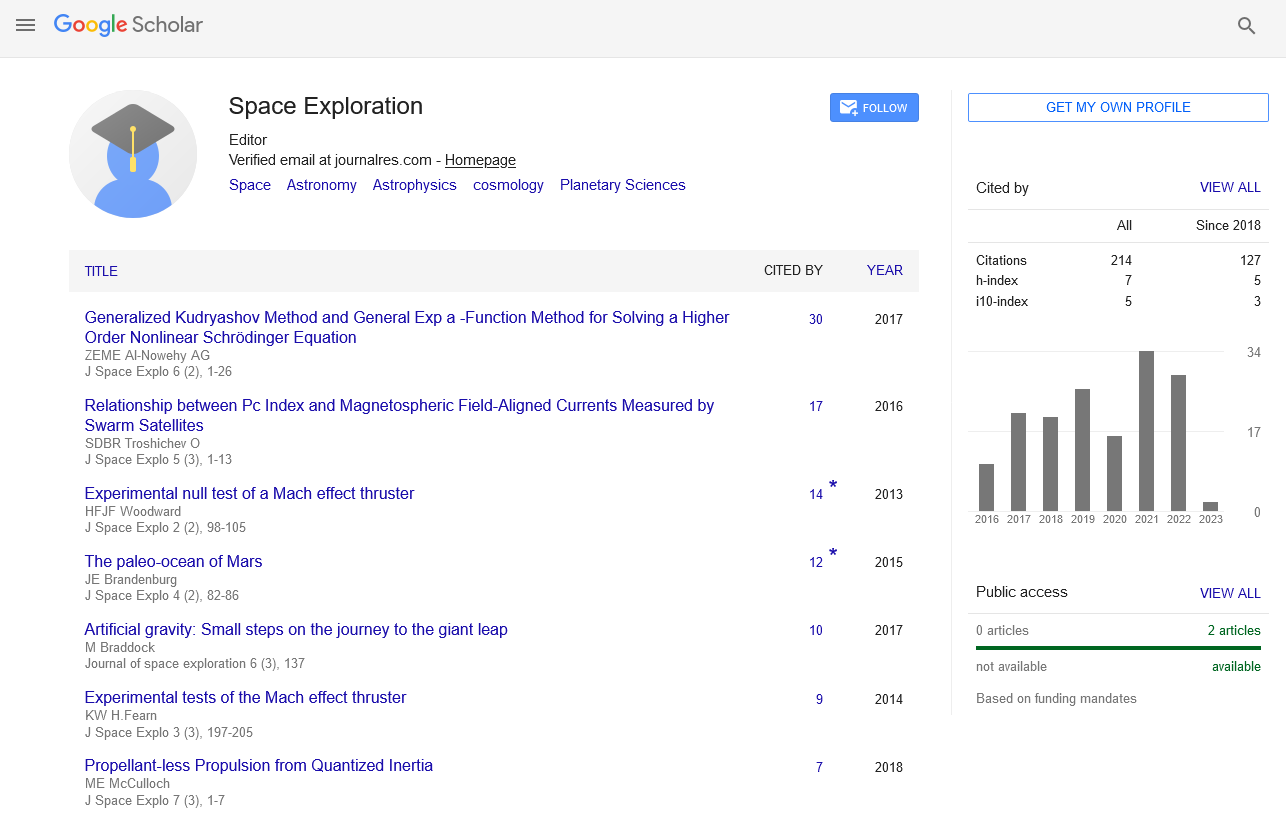Current opinion
, Volume: 11( 8) DOI: 10.37532/2319-9822.2022.11 (8).228Topological investigation of procrystal electron density to improve complicated solid-state ion conductor first-principles simulations
- *Correspondence:
- Angela Guerrero Managing Editor,Journal of Space Exploration, Georgia, E-mail: spaceexploration@scholarres.org
Received: August 1, 2022, Manuscript No.tsse-22-81717;Editor assigned: August 3, 2022, PreQC No.22-81717 (PQ); Reviewed: August 10, 2022, QC No.tsse-22-81717 (Q); Revised: August 17, 2022, Manuscript No. tsse-22-81717 (R); Published date: August 24, 2022.DOI:10.37532/2319-9822.2022.11 (8).228
Citation::Jacobsen D. Topological Investigation of Procrystal Electron Density to Improve Complicated Solid-State Ion Conductor First-Principles Simulations. J Space Explor.2022; 11(8).228
Abstract
Designing high-performance solid-state ion conductors for a variety of electrochemical devices requires an atomic-level understanding of ion migration processes. In this endeavor, first-principles simulations are crucial. Although these techniques have limited access to complicated, low-symmetry structures like interfaces, they are typically computationally demanding. Here, we demonstrate how to effectively address this problem using topological analysis of the procrystal electron density. With the help of two instances, we explain how this technique exceeds the state of the art at the moment. We look into Li-ion transport across grain boundaries in Li3ClO electrolyte in the first. Then, we calculate the diffusion coefficients in the spinel LiTiS2 electrode material as a function of charge carrier concentration
Introduction
Ionic conductors in solid form have several uses in the field of materials research. For instance, they are thought to be crucial in the development of novel functional materials for sensing as well as the rapidly developing energy storage and conversion technologies. For these systems to be successfully applied in high-performance electrochemical devices, ionic transport in those systems must be understood and controlled. Finding ion occupancies, ion migration routes, charge carrier types, point defects, and ion-doping sites at bulk and interfacial structures including grain boundaries and heterophases is often required. A well-established theoretical method for gaining access to these characteristics at the atomistic level is quantum mechanics. With a proven track record, Density Functional Theory (DFT) in particular offers a reasonable trade-off between accuracy and efficiency. To learn more about ion migration processes and the mechanisms that underlie them in complex systems, however, involves laborious studies of complicated potential energy landscapes or the assessment of atomic dynamics, both of which are time-consuming computations. This restricts the use of DFT-based simulations in high-throughput screening campaigns to find novel ionic conductors or to evaluate the performance-related contributions of charge carrier concentration and interfacial structures. Alternatives to DFT-based calculations that need less computing power sometimes sacrifice structural detail, quantitative predictability, and transferability.Finding the lowest energy starting and end state geometries is only one step in the workflows needed to compute kinetic characteristics (such as ion diffusivity), since all conceivable migration pathways must be taken into account and their transition states must also be calculated. Additionally, such procedures should take into account potential metastable sties as well as multistep diffusion mechanisms. Current DFT-based techniques are ideally adapted to carry out such jobs and provide precise predictions in bulk materials that are reasonably simple. Nudged elastic band (NEB) techniques and Ab Initio Molecular Dynamics (AIMD) simulations have shown to be the two most effective strategies in this situation. As recently applied for a set of promising Mg-intercalating materials, one technique to get over the computational restrictions of the NEB method is to estimate the migration barriers using straightforward DFT-derived electrostatic potentials of a framework sub lattice. By examining the electron density distributions from DFT, another recent method enables one to infer an ion migration channel in the crystal structure that is within the predetermined distance limit. However, evaluating the electron density distributions for large structure sets and/or complex structures may take a while. The procrystal density model, on the other hand, is a somewhat sloppy method for total electron density estimates. However, it has been demonstrated elsewhere that due to its speed and moderate accuracy, it may be appropriate for searching for minimal energy routes in a broad variety of structures. The electron density derived using the procrystal technique was in good agreement with the superposition of the free-ion densities for the ionic solid Li2BeF4 ionic crystal. The presence of bond Critical Points (CPs) on interatomic lines in these non-bonded systems was also demonstrated by studies of topological characteristics of procrystal electron density distributions in LiF, MgO, and NaCl crystals. In our most recent research, we looked into the ionic transport characteristics of many well-known and promising potassium-conducting materials that had been chosen using the ICSD geometrical topological screening. The results of the subsequent DFT modelling of the chosen compounds demonstrated that (i) some of the pathways among the selected sets had high migration energies and, as a result, made no contributions to the migration maps, and (ii) a number of effects that cannot be considered within the geometrical-topological approach (different vacancy formation energies, close position of other ions with respect to the pathway, etc.) influence the ion migration properties.
Conclusion
The proposed method can be viewed as a promising tool for finding new ion conducting materials among the large (due to low computational complexity) crystal structure sets accompanied by accurate DFT calculations because the NEB migration energies and RCP densities are consistent. In this instance, using the predicted gradient paths for each independent transition can both speed up the calculations and prevent errors brought on by the initial guess that was made without consideration of the ion trajectory

